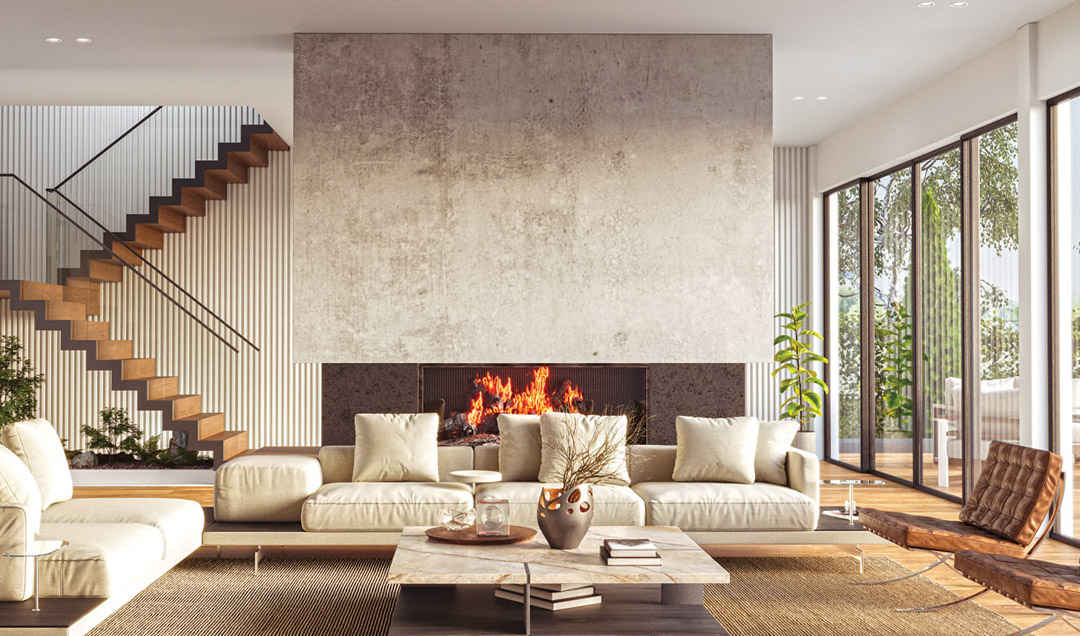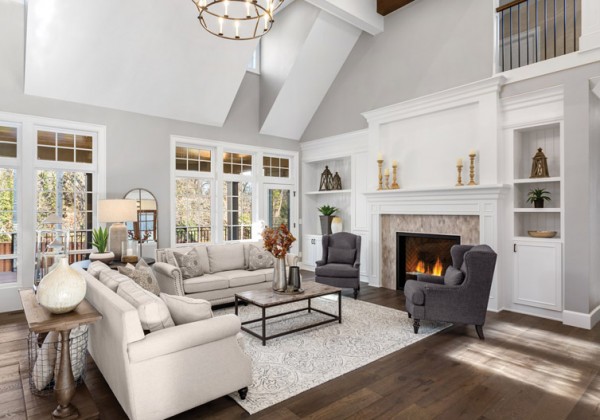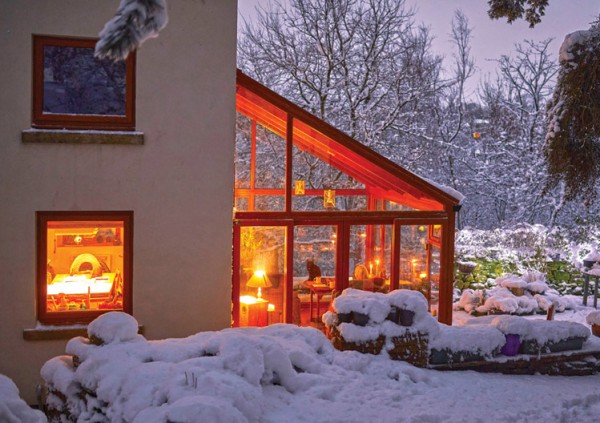Home Is Where the “Hearth” Is

A home heating system is not typically at the forefront of peoples'minds, especially before the onset of winter. If there is any kind of problem with a heating system, it is usually only realized when it's turned on in the winter when heat circulation is most necessary. However, if a heating system has run its course or if a homeowner is just looking for a change, there are plenty of different options available that best suit the lifestyles within each household.
"Addressing your home through your insulation, your ventilation and mechanicals truly benefits everything that is essential to someone, and being able to be attentive to that with seasonal maintenance ensures the best quality of life for your loved ones and the essential belongings in your home," Allied Experts'Home Solutions Director Jose Diaz affirms.
The first step is to assess a home's heating system with the help of a professional to check if any regular maintenance is needed. These often-neglected checkups can save time and money before an easily-fixed issue turns into a bigger problem.
often-neglected checkups can save time and money before an easily-fixed issue turns into a bigger problem.
"The biggest thing is getting your maintenance, and tune-ups in general, done by a qualified professional, who will come out and change the filter, take a look at the heating system in general and make sure that it's working at peak efficiency for the next season," says Jeff Olewine, general manager of C&C Heating and Air Conditioning.
Olewine recommends having biannual inspections: one in spring and one in fall. Even getting started in August through September is better than nothing. Often a lack of general maintenance is the common culprit of issues with home heating systems.
"The most common issues revolve around the blower assembly in the furnace or a dirty air filter. Air filters are often forgotten about," says John Laphen, service manager with Doylestown Air.
Every circumstance is different, so having a professional check the system before it is fired up – especially after not using it for several months – is always safest. A neglected heating system doesn't necessarily indicate danger, but it's always best to prepare for and have a plan for the unexpected.
"The biggest [safety] concern would be being without heat during a cold snap. Another potential risk is the heat exchanger cracking, which can allow carbon monoxide to be released," Laphen continues.
An unexpected broken system – especially during the holidays when spending is maximized – may leave household occupants shivering in what is supposed to be the comfort of their homes until they can find the time availability and funding. In such an urgent situation, it may be difficult to properly assess the next steps, but each situation has a different, more cost-efficient option.
"If someone's looking to replace their system, typically it's when they have a certain amount of issues with a unit that needs repairs and it doesn't make sense to put money into repairing it," says Olewine.
 If efficiency, sustainability and cutting costs are of interest, a newer model might be the best solution. Companies like Allied Experts Home Solutions offer innovative products that are easier to manage while being kind to the environment. The best option for each home can be determined with full home evaluations. In addition to working to assess the needs of your home, an experienced professional may also help cut down on costs as they are knowledgeable of financing options within the industry.
If efficiency, sustainability and cutting costs are of interest, a newer model might be the best solution. Companies like Allied Experts Home Solutions offer innovative products that are easier to manage while being kind to the environment. The best option for each home can be determined with full home evaluations. In addition to working to assess the needs of your home, an experienced professional may also help cut down on costs as they are knowledgeable of financing options within the industry.
"There are beneficial tax breaks that customers should be made aware of with the Inflation Reduction Act. Utility programs and the Department of Energy [within the] federal government are going to be very active in pursuing options to help with energy efficiency and savings in the home. Homeowners should be aware that they have options for assistance," Diaz explains.
Beyond accessibility to cost-saving and government assistance programs, upgrading your system increases efficiency of your home, in turn lowering your heating bill.
Smart home models have heightened connectivity to other devices and are designed to provide a higher performance quality and energy efficiency. These electric "smart" heaters can connect to WiFi and can be controlled through phone and voice apps, some have room sensors to optimize usage and others allow for programmable cycles.
Compared to home heating systems, fireplaces are more geared toward enjoyment, providing heat to only those nearby. Undoubtedly, a burning fire creates a picturesque holiday atmosphere.
"It's more fun than beneficial, because 80% of people are using fireplaces to heat the room a little bit and also to enjoy the fire, smell and noise of the wood when it burns," says Ardian Bejita, owner of Doctor Chimney.
Burning wood requires a supply and it's best to have experience or practice. It is not as cost-effective or sustainable to use wood compared to gas or electricity. Although wood burning fireplaces are harmonious with nostalgia, they too have seen a technological upgrade with dozens of choices.
"First-time buyers really need to consider their lifestyle and their time commitment," Chris Olsen, owner of Newtown Fireplace Shop describes. "Are they looking for ease and convenience, or do they really love the smell and the natural crackle of real wood? Do they have the time to burn, to stack and store wood, or are they going to find more value in having ease with the use of a remote control for gas?"
Olsen and his team strive to customize the aesthetic of new fireplaces to fit the style of each home. Many of the Colonial- and farmhouse-style homes in the New Jersey, Pennsylvania and Delaware regions are already equipped with built-in fireplaces. However, these still need to undergo some considerations before they are used.
"Homes that were built any time before 2010 have a very high chance of having a negative efficiency appliance and solvent, meaning customers don't even realize that it's taking the heat out of their home rather than adding heat value to the home," says Dave Rettinger Jr., owner of Rettinger Fireplace Systems. "And when it's not used, it's just a big hole for cold air to pour into the house. So, we have products that solve that exact problem that many thousands of homeowners, either knowingly or unknowingly, are challenged by today."
Fireplace inserts can help with efficiency and are a great way to upgrade a decades-old, wood-burning fireplace to a safer and more energy efficient option. They will convert an existing fireplace opening to wood, gas or electric and will still release smoke through the chimney. If using a fireplace this winter, one should assess the system itself and the chimney.
"People need to inspect the chimney smoke chamber and the lining. So, they need to go in the house, take a look if there are any cracks, any holes, any missing lining – that's very important," advises Bejita.
Chimneys need to be cleaned and inspected before fireplace use. Chimney liners reduce utility costs, streamline maintenance and cleaning, and allow for more safety. Depending on home- and township-specific codes, different types of liner may be installed, often depending on the type of fireplace and the size of the chimney flue. Liners can be made of stainless steel, high thermal resistance ceramic, clay or aluminum.
Due to all of the necessary aspects that go into a fireplace system that may have to be divided among multiple specialists, some companies will act as a one-stop shop to fully guide a customer through the multifaceted process. Chimney sweeping is required for any system update, which Rettinger Fireplace Systems provides in conjunction with its concierge service.
"If we need a licensed electrician or plumber on the job, we'll hire them for you. If you need permits and inspections, which almost all jobs do, we'll take care of the permits, we'll arrange for the inspections," says Rettinger. "You cannot do anything to an existing fireplace without getting a Level 2 inspection."
The wide range of product options available for heating a home today allow for different types of operation, effect and maintenance. Ultimately, though, warmth in the home is primarily about comfort.
"Homeowners should really take a look at their fireplace to make sure that it's creating an inviting, warm environment that makes their house feel like a home," says Olsen. "Is it providing the ambiance, the atmosphere, the look, the style that fits their energy? They are creating that mindset to make a peaceful home."
Resources:
Allied Experts
Cherry Hill, N.J.
(856) 210-8824
AlliedExperts.com
C&C Heating and Air Conditioning
Souderton, Pa.
(215) 799-0515
CC-HVAC.com
Doctor Chimney
Emerson, N.J.
(201) 981-8382
DoctorChimney.com
Doylestown Air
Pipersville, Pa.
215-598-7494
DoylestownAir.com
Newtown Fireplace Shop
Newtown, Pa.
(215) 968-3981
NewtownFireplaceShop.com
Rettinger Fireplace Systems
Voorhees, N.J.
(856) 317-6490
RettingerFireplace.com
Published (and copyrighted) in House & Home, Volume 24, Issue 9 (September 2024)
For more info on House & Home magazine, click here.
To subscribe to House & Home magazine, click here.
To advertise in House & Home magazine, call 610-272-3120.
